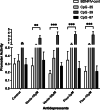BDNF exon IV promoter methylation and antidepressant action: a complex interplay
- PMID: 36572893
- PMCID: PMC9793565
- DOI: 10.1186/s13148-022-01415-3
BDNF exon IV promoter methylation and antidepressant action: a complex interplay
Abstract
Background: BDNF exon IV promoter methylation is a potential biomarker for treatment response to antidepressants in MDD. We have previously shown CpG-87 methylation as a successful biomarker for the prediction of non-response to monoaminergic antidepressants like the SSRI Fluoxetine or the SNRI Venlafaxine. This study aimed to dissect the biological evidence and mechanisms for the functionality of CpG-87 methylation in a cell culture model.
Results: We observed a significant interaction between methylation and antidepressant-mediated transcriptional activity in BDNF exon IV promoter. In addition, antidepressant treatment increased the promoter methylation in a concentration-dependent manner. Further single CpG methylation of -87 did not change the promoter activity, but methylation of CREB domain CpG-39 increased the transcriptional activity in an antidepressant-dependent manner. Interestingly, DNMT3a overexpression also increases the BDNF exon IV transcription and more so in Venlafaxine-treated cells.
Conclusions: The study strengthens the previously reported association between antidepressant treatment and BDNF exon IV promoter methylation as well as hints toward the mechanism of action. We argue that potential CpG methylation biomarkers display a complex synergy with the molecular changes at the neighboring CpG positions, thus highlighting the importance of epiallele analyses.
Keywords: Antidepressants; BDNF exon IV promoter; CREB; MeCP2; Methylation; Site-directed mutagenesis.
© 2022. The Author(s).
Conflict of interest statement
The authors declare that they have no competing interests.
Figures






Similar articles
-
BDNF Plasma Levels and BDNF Exon IV Promoter Methylation as Predictors for Antidepressant Treatment Response.Front Psychiatry. 2018 Oct 26;9:511. doi: 10.3389/fpsyt.2018.00511. eCollection 2018. Front Psychiatry. 2018. PMID: 30459647 Free PMC article.
-
DNA methylations of brain-derived neurotrophic factor exon VI are associated with major depressive disorder and antidepressant-induced remission in females.J Affect Disord. 2021 Dec 1;295:101-107. doi: 10.1016/j.jad.2021.08.016. Epub 2021 Aug 12. J Affect Disord. 2021. PMID: 34418778
-
Biphasic change in BDNF gene expression following antidepressant drug treatment explained by differential transcript regulation.Brain Res. 2006 Aug 23;1106(1):12-20. doi: 10.1016/j.brainres.2006.05.063. Epub 2006 Jul 13. Brain Res. 2006. PMID: 16842762
-
Effects of maternal separation and antidepressant drug on epigenetic regulation of the brain-derived neurotrophic factor exon I promoter in the adult rat hippocampus.Psychiatry Clin Neurosci. 2018 Apr;72(4):255-265. doi: 10.1111/pcn.12609. Epub 2017 Nov 14. Psychiatry Clin Neurosci. 2018. PMID: 28990703
-
A new methodological approach for in vitro determination of the role of DNA methylation on transcription factor binding using AlphaScreen® analysis: Focus on CREB1 binding at hBDNF promoter IV.J Neurosci Methods. 2020 Jul 15;341:108720. doi: 10.1016/j.jneumeth.2020.108720. Epub 2020 May 13. J Neurosci Methods. 2020. PMID: 32416472 Review.
Cited by
-
Brain region-specific roles of brain-derived neurotrophic factor in social stress-induced depressive-like behavior.Neural Regen Res. 2025 Jan 1;20(1):159-173. doi: 10.4103/NRR.NRR-D-23-01419. Epub 2024 Apr 3. Neural Regen Res. 2025. PMID: 38767484 Free PMC article.
-
An ancient polymorphic regulatory region within the BDNF gene associated with obesity modulates anxiety-like behaviour in mice and humans.Mol Psychiatry. 2024 Mar;29(3):660-670. doi: 10.1038/s41380-023-02359-7. Epub 2024 Jan 16. Mol Psychiatry. 2024. PMID: 38228888 Free PMC article.
-
BDNF Unveiled: Exploring Its Role in Major Depression Disorder Serotonergic Imbalance and Associated Stress Conditions.Pharmaceutics. 2023 Aug 3;15(8):2081. doi: 10.3390/pharmaceutics15082081. Pharmaceutics. 2023. PMID: 37631295 Free PMC article. Review.
-
Polyphenol-Based Nutritional Strategies Combined With Exercise for Brain Function and Glioma Control: Focus on Epigenetic Modifications, Cognitive Function, Learning and Memory Processes.Food Sci Nutr. 2025 Aug 10;13(8):e70758. doi: 10.1002/fsn3.70758. eCollection 2025 Aug. Food Sci Nutr. 2025. PMID: 40792048 Free PMC article. Review.
-
Validation of the predictive value of BDNF -87 methylation for antidepressant treatment success in severely depressed patients-a randomized rater-blinded trial.Trials. 2024 Apr 9;25(1):247. doi: 10.1186/s13063-024-08061-5. Trials. 2024. PMID: 38594753 Free PMC article. Clinical Trial.
References
-
- Fuchikami M, Morinobu S, Segawa M, Okamoto Y, Yamawaki S, Ozaki N, Inoue T, Kusumi I, Koyama T, Tsuchiyama K, et al. DNA methylation profiles of the brain-derived neurotrophic factor (BDNF) gene as a potent diagnostic biomarker in major depression. PLoS ONE. 2011;6(8):e23881. doi: 10.1371/journal.pone.0023881. - DOI - PMC - PubMed
Publication types
MeSH terms
Substances
LinkOut - more resources
Full Text Sources
Research Materials

